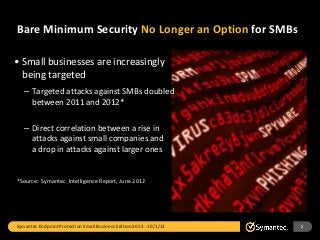

- #SYMANTEC ENDPOINT MANAGER 14 ON PREMISES INSTALL#
- #SYMANTEC ENDPOINT MANAGER 14 ON PREMISES UPGRADE#
- #SYMANTEC ENDPOINT MANAGER 14 ON PREMISES LICENSE#
- #SYMANTEC ENDPOINT MANAGER 14 ON PREMISES WINDOWS#
I am a goal-oriented Infrastructure System Engineer and Information System Security Officer with over 10 years’ of experience in planning and implementation of network, servers, virtualization and security technologies.



If you uncheck this option, the new certificate uses the same key pair as before, which lowers the Symantec Endpoint Protection Manager server security profile in the case of a compromised key pair. Generate new Keys generates a new certificate with a new key pair (public and private keys). Make sure that Generate new Keys is checked, and then click Next.
#SYMANTEC ENDPOINT MANAGER 14 ON PREMISES WINDOWS#
Since a new Windows Server 2019: W2K19-APPS01 has a new IP and hostname, we will follow an additional set of steps to migrate clients using a Management Server List. Click Nextī) Click Start > Programs > Symantec Endpoint Protection Manager > Database Backup and Restore.Ĭ) Follow the on-screen steps to restore the database.
#SYMANTEC ENDPOINT MANAGER 14 ON PREMISES INSTALL#
Copy the recovery file to a shared location.Ī) Install SEPM, When the Management Server Configuration Wizard runs, select Recovery Configuration and browse to the location of the previously saved recovery file and click net.ī) Choose install my first site (since I am going to restore the recovery database)Ĭ) Verify port information and click Nextĭ) Confirm database settings and provide credentials and click NextĮ) If connecting to an existing DB, you’ll be warned that the server name exists and asked if you want to replace it.By default, the file is located in the following directory:Ĭ:\Program Files (x86)\Symantec\Symantec Endpoint Protection Manager\Server Private Key Backup\recovery_timestamp.zip
#SYMANTEC ENDPOINT MANAGER 14 ON PREMISES LICENSE#
The recovery file includes the encryption password, keystore files domain ID, certificate files, license files, and port numbers.The backup file is called date_ timestamp.zip. By default, the database backup folder is saved to the following default location:Ĭ:\Program Files (x86)\Symantec\Symantec Endpoint Protection Manager\data\backup Navigate to SEPM Database back up and Restore and back up the database.New Windows Server 2019 VM: W2K19-APPS01. For this article, I am testing on my lab. SEPM in my environment run’s on embedded databases, it is a smooth ride.
#SYMANTEC ENDPOINT MANAGER 14 ON PREMISES UPGRADE#
Since DCSA approved deployment of Windows Server 2019, it is a season for me to migrate / upgrade all the servers and applications from Windows Server 2012 R2 to Windows Server 2019. Way back in 20, I successfully migration all applications and servers from Windows Server 2008 R2 to Windows Server 2012 R2. Posted in IT, Microsoft, Windows Server 2012


 0 kommentar(er)
0 kommentar(er)
